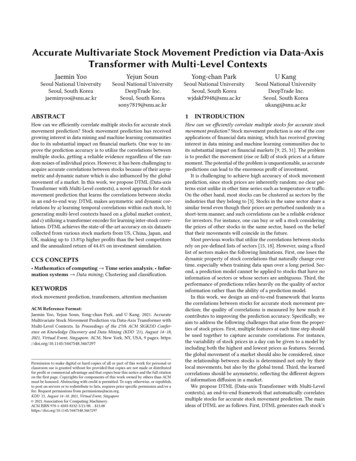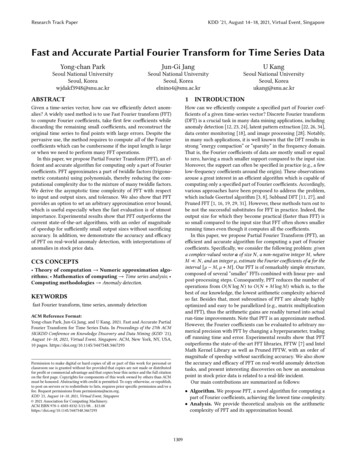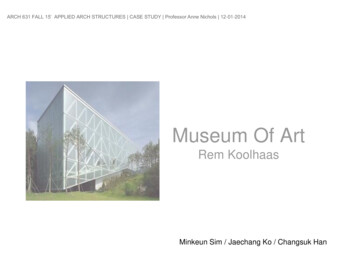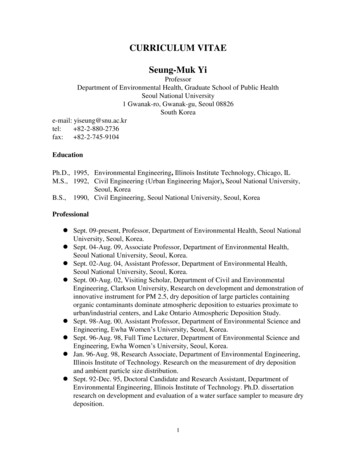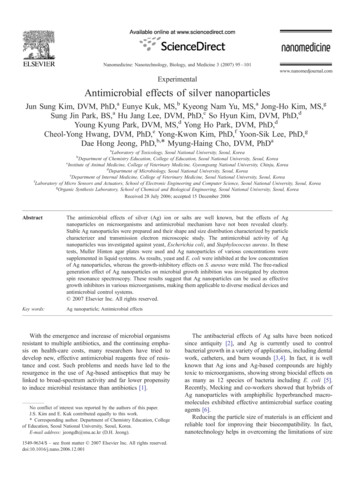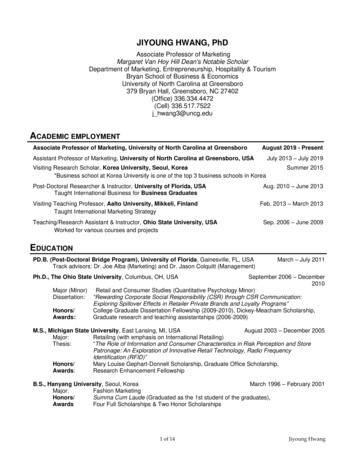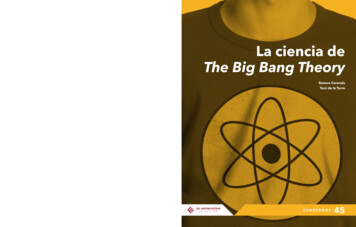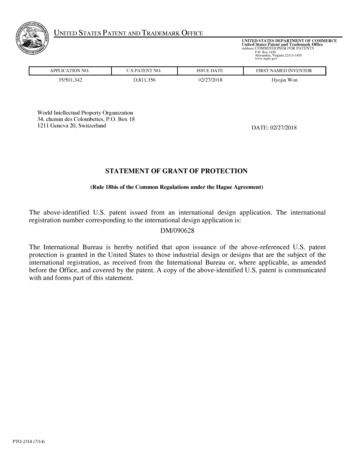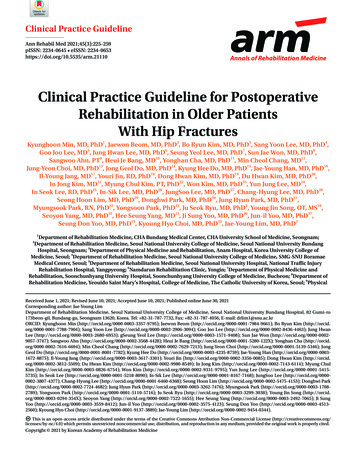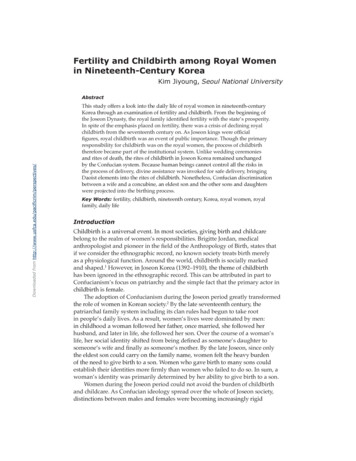
Transcription
Asia Pacific Perspectives Fall/Winter 2013–14Fertility and Childbirth among Royal Womenin Nineteenth-Century KoreaKim Jiyoung, Seoul National UniversityDownloaded from actThis study offers a look into the daily life of royal women in nineteenth-centuryKorea through an examination of fertility and childbirth. From the beginning ofthe Joseon Dynasty, the royal family identified fertility with the state’s prosperity.In spite of the emphasis placed on fertility, there was a crisis of declining royalchildbirth from the seventeenth century on. As Joseon kings were officialfigures, royal childbirth was an event of public importance. Though the primaryresponsibility for childbirth was on the royal women, the process of childbirththerefore became part of the institutional system. Unlike wedding ceremoniesand rites of death, the rites of childbirth in Joseon Korea remained unchangedby the Confucian system. Because human beings cannot control all the risks inthe process of delivery, divine assistance was invoked for safe delivery, bringingDaoist elements into the rites of childbirth. Nonetheless, Confucian discriminationbetween a wife and a concubine, an eldest son and the other sons and daughterswere projected into the birthing process.Key Words: fertility, childbirth, nineteenth century, Korea, royal women, royalfamily, daily lifeIntroductionChildbirth is a universal event. In most societies, giving birth and childcarebelong to the realm of women’s responsibilities. Brigitte Jordan, medicalanthropologist and pioneer in the field of the Anthropology of Birth, states thatif we consider the ethnographic record, no known society treats birth merelyas a physiological function. Around the world, childbirth is socially markedand shaped.1 However, in Joseon Korea (1392–1910), the theme of childbirthhas been ignored in the ethnographic record. This can be attributed in part toConfucianism’s focus on patriarchy and the simple fact that the primary actor inchildbirth is female.The adoption of Confucianism during the Joseon period greatly transformedthe role of women in Korean society.2 By the late seventeenth century, thepatriarchal family system including its clan rules had begun to take rootin people’s daily lives. As a result, women’s lives were dominated by men:in childhood a woman followed her father, once married, she followed herhusband, and later in life, she followed her son. Over the course of a woman’slife, her social identity shifted from being defined as someone’s daughter tosomeone’s wife and finally as someone’s mother. By the late Joseon, since onlythe eldest son could carry on the family name, women felt the heavy burdenof the need to give birth to a son. Women who gave birth to many sons couldestablish their identities more firmly than women who failed to do so. In sum, awoman’s identity was primarily determined by her ability to give birth to a son.Women during the Joseon period could not avoid the burden of childbirthand childcare. As Confucian ideology spread over the whole of Joseon society,distinctions between males and females were becoming increasingly rigid
Downloaded from http://www.usfca.edu/pacificrim/perspectives/Asia Pacific Perspectives Fall/Winter 2013–14while the sphere of women’s activities was narrowing to focus on the family.3In the epitaphs of ruling aristocrats of the time, males were described as havingofficial careers in the public sphere, while their wives as females were definedby their duties in the private sphere, namely childbirth, childcare, and domesticmanagement. Even though this new social climate highlighted the importanceof childbirth, it became an event that occurred in invisible, private, and silentspaces.Whereas Western society includes childbirth in the rites of passage, Joseonsociety excluded it from such rites. People’s daily lives in Korea were organizedaround Confucian family rites as established by the Chinese Confucianphilosopher Zhu Xi (1130–1200). These rites included the coming-of-ageceremony, marriage, death, and ancestor worship. With lives centered around theactivities of men, childbirth was noticeably absent from official rites.Confucianism’s promotion of patriarchy and continuance of the familyline led to an increased interest at the time in the fertility of women. Despitethe importance of women’s fertility and childbirth for Joseon society, androyal society in particular, the study of childbirth has received little attentionfrom Korean scholars. Some data has been collected in the name of sansok (folkknowledge of childbirth).4 However, the materials that the folklorists havegathered, have focused primarily on traditional practices of delivery in modernrural areas. Since the arrival of Western medicine in the late-nineteenth century,these birthing traditions have undergone tremendous change.Since 2000, female anthropologists in Korea have begun to pay attention tochildbirth among the middle class in modern cities.5 The studies focusing onchildbirth among royal women in the palace have dealt primarily with courtcustoms and court medicine.6 As a result of this research, we can now visualizethe scenery of the delivery room in detail. However, it is important not only todescribe the setting but to understand the meanings of fertility and deliveryin the context of Korea’s gender history. So the examination of fertility andchildbirth in Joseon society can give us a chance to understand the culturalmeanings of the behaviors of female agents in nineteenth-century Korea.In order to understand the culture of childbirth among royal women inJoseon society, we must answer questions such as: Who were these womengiving birth in the palace? What were their social positions? How did the fertilityof royal women change during the nineteenth century? What was the process ofchildbirth? Where in the process did women’s social positions become distinctfrom one another?This paper will first explore the idea of fertility among the Yi royal familyand the institution through which the idea came into reality. The differences instatus among women in the palace were usually determined by their relations,whether in private or in public, with the king, and whether or not they gave birthto a royal baby. Focusing on some characteristics of their fertility in nineteenthcentury Korea, I will also expand the coverage of the study into the late JoseonDynasty. Next, this paper will examine the process of childbirth among royalwomen by comparing Queen MyeongSeong (1851–95), who gave birth to the lastemperor, SunJong (r. 1907–10), with the royal concubine Eom-ssi (1854–1911),Fertility and Childbirth among Royal Women / Kim 85
Downloaded from http://www.usfca.edu/pacificrim/perspectives/Asia Pacific Perspectives Fall/Winter 2013–14whose son was Young Chin-Wang (1897–1970). This comparison will reveal indetail how the process of delivery differed according to a woman’s social status.As might be expected, there are very few documents which record childbirthin Joseon Korea, whether it occurred inside or outside the palace.7 As a result,there are limits to understanding childbirth among royal women in the contextof the everyday life of the royal family. This paper relies on general sources ofcourt history such as the code of law known as the National Code, the Annals ofthe Joseon Dynasty, and the Daily Records of the Secretariat. Other sources whichare especially related to delivery have also been consulted; these documents,primarily from the nineteenth century, include the Manual for a Queen’s Childbirth,the Diary about Royal Concubine’s Delivery, and Inner Palace Registries. Amongthe Inner Palace Registries, one finds informal stories about royal women givingbirth as recorded by court ladies; these record events and details that the moreformal histories of the court would not cover. Additional historical sourcesrelated to the prosperity of the royal family have also been referenced as well asthe Book of Genealogical Lineage of the Joseon Royal Family.8 Last but not least, thispaper will also examine a painting that appeared in royal wedding ceremoniesin nineteenth-century Korea. Though the painting is very important for us tounderstand childbirth in the Joseon Dynasty, it has not received any attentionfrom scholars until now. As will be seen, all of these materials give context tochildbirth among royal women in nineteenth-century Korea.The Royal Family’s Desire for FertilityThe royal family during the Joseon period referred to having many children asJongSa-Ji-Kyeung. JongSa is a kind of grasshopper that lays about ninety-nine eggsat a time. So the phrase may be translated into “a cause for congratulations forhaving numerous children like a large swarm of grasshoppers.” The term firstappeared in the Chinese classic the Book of Odes. It symbolically reveals the royalfamily’s desire for fertility.From the beginning of the Joseon Dynasty, its founder King Taejo (r. 1392–98) hoped that the royal family would follow the model of the Zhou Dynastyin ancient China by having many offspring and prosperity, generation aftergeneration.9During the Joseon Dynasty, the phrase JongSa-Ji-Kyeung appeared in at leasttwo different contexts. First, we can find it in references to the wedding ceremonyof the royal family. It appears in documents called Ok-ChaekMun, which were akind of formal letter of appointment to a queen.10 In addition, we can also findthe phrase in documents which were used to select and install a concubine forobtaining an heir to the throne.11 The most important obligation of women whocame into the royal palace through marriage was to give birth to royal children.Women who fulfilled this obligation could retain and oftentimes even improvetheir social standing.We also find the phrase in congratulatory messages offered to royalnewlyweds. The following is a congratulatory message from some ministers tonewlyweds King Gojong (r. 1863–1907) and Queen MyeongSeong on March 22,1866:Fertility and Childbirth among Royal Women / Kim 86
Asia Pacific Perspectives Fall/Winter 2013–14The rite of marriage went smoothly on the perfect day and at the perfect time. Your highnesscame in person to the venue and accepted many other people’s congratulations. The marriagein which a king gains a queen is a cause for congratulations and a source of all blessings. Weare singing the song which congratulates people for having [numerous] children like a largeswarm of grasshoppers [emphasis added]. For the following thousands of millions of years,there will be a beautiful story about this. We, [your] subjects, desperately hope that yourhighness will have the cause for congratulations for having a lot of children.12Downloaded from d, the term appeared when the elderly in the royal family and the king’smen expressed their concerns about a king or a crown prince not having children,especially when there was no heir to the throne. In the following example, thequeen’s grandmother expresses her concerns about the lack of an heir apparent:The queen’s grandmother Sunwon [1789–1857], said to the ministers, “The fate of theKingdom only depends on the king. But even though he is in the prime of his life, we havenot been able to see the happy event of having babies. Unfortunately, the queen has beensick but the medicine has not worked for her, which has deeply distressed the queen’s motherand myself. All the people in the country are expecting the happy event to take place, not tomention the king’s ancestral spirits. It is urgent that the king have an heir to the throne.If we, following the royal family’s precedent, choose one daughter among the aristocratic classas the king’s concubine, we will secure an heir to the throne. I am sorry that I am giving youthis instruction in Korean instead of classical Chinese. But as this matter is very crucial to thefate of the kingdom, I have had no choice except to give such an instruction. You should makesure that we can see a cause for congratulations for having children like a large swarm ofgrasshoppers [emphasis added].”13The birth of royal children was one of the primary concerns of elders of the royalfamily, including the king and queen, because it determined the perpetuity oftheir dynasty and the prosperity of the royal family. When a king took overthe throne after his father passed away, the royal family was looking forwardin earnest to having an heir for him. So if the birth of the king’s eldest son wasdelayed, like in the case of King Heonjong (r. 1834–49) above, the delay wasconsidered as a kind of crisis for the kingdom.In the royal family, fertility meant prosperity of the state itself as well as theroyal family. So JongSa-Ji-Kyeung was considered to be identical to “a cause forcongratulations for the kingdom,” which was also called JongSa-Ji-Kyeung. Here,Jong, an abbreviation for Jongmyo, means “the royal ancestor’s shrine.” Sa standsfor SaJik, or “the gods of soil and grain.”The royal wedding ceremony also shows that the royal family eagerlydesired fertility. The desire for fertility appeared, for example, in the process ofchoosing the officials in charge of the wedding ceremony. They were selectedamong the “entirely blessed,” people who had shared years happily togetherwith their spouses, led a healthy life without illness, had long lives, and hadmany “sons.”14 Joseon society became a patrilineal one due to Confucian clanrules. The essence of the patrilineal society was the success brought to a man’sfamily through his sons. Thus, in late Joseon, people eagerly wanted to have sons,not daughters.In the nineteenth century, a new painting appeared in the royal weddingceremony. The painting supports the argument that fertility became a veryimportant obligation for royal women in late Joseon. Just prior to marriage, theFertility and Childbirth among Royal Women / Kim 87
Asia Pacific Perspectives Fall/Winter 2013–14bride would spend time in the detached palace, Byeolgung. This palace was atemporary place, where the bride would stay and receive an education duringthe period between being selected as the future queen until she entered the mainpalace, Jounggung, along with the king. Once selected, she could no longer visither home outside the palace.Within the detached palace there was a special folding screen on which waspainted the Painting of the Luxurious Life of Guo Ziyi. The painting first appearedin the 1802 royal wedding ceremony and offered well-wishes for fertility andcontinued to appear in the detached palace through 1882.YearDownloaded from he Wedding Ceremony (King/Queen)Folding ScreenPlaced in the Detached PalaceKing Sunjo/Queen Sunwon, Andong Kim-ssiGB1819King Ikjong/Queen Sinjeong, Pungyang Cho-ssiGH1837King Heonjong/Queen Hyohyeon, Andong Kim-ssiGB1844King Heonjong/Queen Hyojeong, Namyang Hong-ssiG1851King Cheoljong/Queen Cheolin, Andong Kim-ssiG1866King Gojong/Queen Myeongseong, Yeoheung Min-ssiBGB1882King Sunjong/Queen Sunmyeong, Yeoheung Min-ssiG(Table 1. Royal Weddings in the Nineteenth Century and Making Folding Screens)15G: Luxurious Life of Guo ZiyiB: Bird and AnimalH: Hundreds of ChildrenHThe main subject of the painting was a general-turned-king named Guo Ziyi(697–781) from the Tang Dynasty in China, who had suppressed the revolt ofAn Lushan (703–57) in the year 755. As a result of his distinguished service tothe imperial court, he was made a prince. Guo had many children—fifteen intotal, eight sons and seven daughters—and lived a long life, reaching the age ofalmost eighty-five. He symbolized a person who had been blessed by heaven.So Painting of the Luxurious Life of Guo Ziyi was called Guo Ziyi Palja-Chilseo-Do,which can be translated as “Painting of Guo Ziyi Who Has Eight Sons (Palja) andSeven Sons-in-Law (Chilseo).” There was also a novel, Guobunyang-Jeon, whichdescribed the life of Guo. Both the novel and the painting were popular amongthe upper class in nineteenth-century Korea.Why did the Painting of the Luxurious Life of Guo Ziyi suddenly appear inroyal weddings in nineteenth-century Korea? According to an analysis fromart history, the painting did not appear anywhere in China. It is said that theFertility and Childbirth among Royal Women / Kim 88
Asia Pacific Perspectives Fall/Winter 2013–14Downloaded from ing wasFig. 1. Painting of the Luxurious Life of Guo Ziyipainting was created during the late Joseon by combining several features fromother paintings which had different themes.16The first reference to the painting appears in Eoje-si, a poem written by KingSukjong (r. 1674–1720).17 There are actually two poems written by the king thatcontain references to the painting.18 King Sukjong bestowed both the poemsand the painting on his successor who later would become King Kyeongjong (r.1720–24 ):Giving the painting Painting of the Luxurious Life of Guo Ziyi to my son.Traditionally, it is said that Guo Ziyi was a very blessed manThere are sons, sons-in-laws, and grandchildren together in the paintingIt is not an accident that the painting was drawn on canvasDo put the picture next to you and appreciate it at all timesReceive every happiness in the world and longevityKing Kyeongjong, who in 1696 married the daughter of Sim ho, later QueenDanui Sim-ssi (1686–1718), had suffered from diseases after his birthmotherHuibin Jang-ssi (d. 1701) passed away. So King Sukjong gave the painting to hisson, hoping that his son, who was weak and had no children, would be like themain character, Guo Ziyi, who lived a long life free from disease and blessed bymany children.Prior to the sudden appearance of the painting in 1802, there had been acontinuous decrease in the number of royal children, especially after the reign ofFertility and Childbirth among Royal Women / Kim 89
Asia Pacific Perspectives Fall/Winter 2013–14Downloaded from http://www.usfca.edu/pacificrim/perspectives/King InJo (r. 1623–49).19 The decrease in the number of royal children from theseventeenth century caused a variety of political problems related to successionto the throne in the eighteenth century. Finally, in the nineteenth century, as thepower of the royal family weakened, its authority fell as well. For example, in thenineteenth century, King Heonjong (r. 1834–49) had no children to take over histhrone and was forced to adopt a son from a collateral line. This son, who becameKing Cheoljong (r. 1849–63), had no successor either. As a result, King Gojong,the heir of King Cheoljong, also came from a collateral line. The more the royalfamily desired fertility, the more “eight sons and seven daughters” became thegoal of the royal family. The placement of the folding screen with the paintingPainting of the Luxurious Life of Guo Ziyi in the detached palace, where the womenwere educated, reveals that for women the duty of delivering children becamemore important than ever.Royal Women in the Nae-MyeongbuBefore examining childbirth among royal women during the nineteenth century,one must first examine how the hierarchy among royal women was solidifiedthrough a system of royal concubinage put in place to ensure numerous offspringfor the royal family. The system of royal concubines started being discussedduring the early Joseon Dynasty. By the reign of King Seongjong (r. 1469–94),regulations concerning concubines had an achieved statutory form.20 A statutecalled for the creation of a governmental department known as Nae-Myeongbu. Itconsisted of all the women in the palace and was controlled by the queen. Withinthe Nae-Myeongbu were two groups: the Nae-gwan and the Gung-gwan. The Naegwan included royal concubines who were given a title corresponding to “one ofthe eight ranks of Nae-Myeongbu.” The Gung-gwan was comprised of court ladieswho had a chance to become the king’s concubine and were conferred a titlecorresponding to “one of the ten ranks of Nae-Myeongbu.”However, the statute was not fully realized, and in practice varied dependingupon the situation of the royal family. During the reign of Emperor Sunjong, acouple of senior court ladies once said that the titles listed in the statute were notreally given to court ladies, except during special events such as weddings andbanquets of the royal family. Court ladies were usually called just Nain, whichmeans “a women in the palace,” and their ordinary tasks determined their realtitles.21Court ladies served the members of the royal family. They were forbidden tomarry and were not permitted to leave the palace. In general, they were nothingbut “women of the king.” Their duties included washing, cooking, cleaning,sewing, making beds, etc. Those who worked as personal maids and waited onthe king in his bedroom were called Jimil-Nain and had the chance to receiveSeungeun, the king’s blessing. In this case, Seungeun means to go to bed withthe king. Jimil-Nain were only three to four years old when they entered serviceas court ladies, much younger than the age of twelve when other court ladiesusually entered the palace. If they had the king’s blessing they had the chance,albeit rare, of being promoted to royal concubine.22Fertility and Childbirth among Royal Women / Kim 90
Asia Pacific Perspectives Fall/Winter 2013–14Office ofAge atEntranceAge at Capping Ceremony Age at Promotionto Palace Matron(15 years after entrance)Secretariat3–418–1943–44Sewing and Stitching6–721–2256–57Embroidery and Decoration6–721–2256–57Bath and Toiletaround 12around 27around 62Food and Mealsaround 12around 27around 62Snacksaround 12around 27around 62Laundryaround 12around 27around 62Downloaded from e 2. Age of Court Ladies According to Department (late 19 –early 20th centuries)thThere were two kinds of royal concubines: Gantaek-Hugung and SeungeunHugung. Gantaek-Hugung were selected from among the daughters of aristocraticfamilies. King Taejong (r. 1400–18) made a statement that there should be threeGantaek-Hugung. This differed from China, where a king could choose ninewomen.23 Gantaek-Hugung started climbing up a ladder of titles from a higherlevel than Seungeun-Hugung, who are discussed below. Nevertheless, as thesocial distinction between wife and concubine was very strict in the late JoseonDynasty, aristocratic families were reluctant to give their daughters away to theking to be a concubine as opposed to his queen.24Before King Seonjo (r. 1568–1608), there were some cases of a concubinegiving birth to a son being elevated to the position of queen. But during laterreigns, even if there was a concubine who delivered a son, the royal familypreferred selecting a new queen rather than promoting a concubine. Towards thelate Joseon, as clan rules became more concretized, the distinction between wifeand concubine became stricter than earlier.On the other hand, the Seungeun-Hugung was a court lady who wasblessed with the king’s grace and given the title of king’s concubine. In general,Seungeun-Hugung were from the lower class. If she bore a king’s child, she wasgiven a title. But this title was no higher than that of a Gantaek-Hugung. KingGojong had no women of the rank of Gantaek-Hugung, only those at the levelof Seungeun-Hugung, eight of whom gave birth to his children.25 One of hisconcubines, Eom-ssi, had simply been a court lady until 1897, when she gavebirth to the prince who would later become Youngchin-Wang. Just three daysafter his delivery, she was given the title of royal concubine.26According to the Book of Genealogical Lineage of the Joseon Royal Family, duringthe entire Joseon Dynasty there were a total of 273 children in the royal family.Of these, 93 children had been delivered by queens and 180 were from royalconcubines, some two thirds of the total. Of the 273 royal children, 151 were sonsand 122 were daughters, namely there were more sons than daughters.27 Thestatistics show that the practice of having concubines actually helped the royalfamily produce more offspring.Fertility and Childbirth among Royal Women / Kim 91
Downloaded from http://www.usfca.edu/pacificrim/perspectives/Asia Pacific Perspectives Fall/Winter 2013–14Declining Fertility among QueensHow fertile were queens in nineteenth-century Korea? How was fertility definedduring this period? In order to answer these questions, I will compare QueenMyeongSeong with other Joseon-period queens, in terms of age at the time ofmarriage, age at the time of first delivery, the interval between deliveries, andnumber of the children.In late-Joseon Korea, queens got married earlier than in previous years. Inthe early years of the Joseon Dynasty, the age of queens at the time of marriagewas usually thirteen–fifteen years old. In the mid-seventeenth century, startingfrom Queen MyeongSeong, who was the wife of King Hyeonjong (r. 1659–74),the age at the time of marriage was lowered to ten–eleven years old. In thelate-Joseon period, however, when the first queen happened to pass away, theking had to remarry a new queen. In this case, they called the new queen Gye-Bi,which means “a successor to the first queen.” The age at the time of marriage forthe Gye-Bi was relatively high at around fifteen years old.While age at the time of royal marriage decreased toward the late Joseon,the average age of first delivery for queens remained consistent at about twentyyears old throughout the period. The interval between deliveries varied fromone year to three years. Queens tended to start giving birth to children at aroundage twenty and stopped in their early thirties. It is clear that queens did not givebirth to children throughout the normal childbearing period from age fifteen toforty-nine. There are many reasons that queens stopped giving birth, but mostlikely this was due to the fact that it was dangerous to give birth to children laterin life, and many queens suffered from postnatal diseases.The most fertile queen of the Joseon Dynasty was Queen Soheon, wife ofKing Sejong (r. 1418–50), the well-known creator of the Korean alphabet, Hangul.She had eight sons and two daughters. Looking at her pregnancies, one finds aninteresting fact about the fertility of the queens during the Joseon period.Queen Soheon married King Sejong at the age of fourteen and gave birthto their first child at the age of eighteen. In the beginning, she gave birth almostevery one or two years, producing a total of six children in a row. About sevenyears later, she started giving birth again and delivered four more children untilshe reached the age of forty. It would not have been possible for the queen toraise all the children without the help of wet nurses selected from the lowerclass from outside the palace and babysitters who were selected among the courtladies. These women lessened the queen’s burden in raising her children so thatshe could give birth to several children in a row.Due to the support of the royal family, there were no financial difficulties forraising children. But giving birth to children in quick succession could potentiallycause health problems for the queen, so she needed some time to rest and regainher strength. In addition, the queen had to officially play a role in controlling theNae-Myeongbu.In the nineteenth century, the fertility of queens rose slightly except in thecase of King Heunjong’s queen. Most royal babies died early, except for thoseof King Sunjo. After King Injo, the fertility of the royal family dropped notablyand the death rate of royal children rose sharply. As a result, the number ofliving children in the royal family decreased. The death rate of royal childrenFertility and Childbirth among Royal Women / Kim 92
Asia Pacific Perspectives Fall/Winter 2013–14Downloaded from d during the nineteenth century. For example, among the offspring ofKing Cheoljong, namely one son and ten daughters, only one daughter, PrincessYeonghye, daughter of Seungeun-Hugung Sukui Beom-ssi, survived.KingQueenSunjoSunwonYear ofBirth1789Age atMarriage14Age atDeliveryBirthOrderName ssMeongon1810303rdPrincessBonkon1818324thDied shortlyafter 21stDied shortlyafter birth1858GojongMyeongseong185116211stDied shortlyafter birth1871232thDied shortlyafter birth1873243thSunjong1874254thDied shortlyafter birth1875285thDied shortlyafter birth1878SunjongSun (Table 3. Fertility of Queens in Nineteenth-Century Korea)In the late-nineteenth century, Queen MyeongSeong had four sons and onedaughter in total. She married King Gojong at the age of sixteen, which wasconsidered slightly late. From the age of twenty-one to twenty-eight, she gavebirth every one to two years and had five children. The age at which she stoppedgiving birth appears to be somewhat early when compared with the cases ofother queens. Why was this? In the nineteenth century, children of the royalfamily usually died soon after birth. Queen MyeongSeong’s children were notexempt from such a harsh fate. Four of her five children died shortly after birth.Also, the political situation in the late-nineteenth century was notably unstable.The royal couple was married in 1866, when a skirmish with France occurred.This period was followed by armed conflicts with other Western countries. InFertility and Childbirth among Royal Women / Kim 93
Downloaded from http://www.usfca.edu/pacificrim/perspectives/Asia Pacific Perspectives Fall/Winter 2013–141876, after the Treaty of Ganghwa was signed with Japan, Joseon was forced toopen its doors to Western cultures. During this process, King Gojong did notget along with his father Heungseon-Daewongun (1820–98). In the midd
Kim Jiyoung, Seoul National University Abstract This study offers a look into the daily life of royal women in nineteenth-century Korea through an examination of fertility and childbirth. From the beginning of the Joseon Dynasty, the royal family identified fertility with the state's prosperity.
